@EtoDemerzel
2017-11-18T14:39:49.000000Z
字数 12617
阅读 2990
机器学习week5 ex4 review
机器学习 吴恩达
这周的作业主要关于反向传播算法(Backpropagation ,or BP)
1 Neural Networks
在上一次exercise里,我们通过使用神经网络的前馈传播算法(feedforward propagation),利用给定的权重来识别手写的数字。在这一此我们需要通过反向传播算法计算出权重。
1.1 Visualizing the data
脚本文件ex4.m通过调用函数displayData载入数据,并以二维图像的形式展示。(以下代码随机选择其中的100个数字进行展示)
load('ex4data1.mat');m = size(X, 1);% Randomly select 100 data points to displaysel = randperm(size(X, 1));sel = sel(1:100);displayData(X(sel, :));
这次的数据与上次exercise相同,都是如下图片:
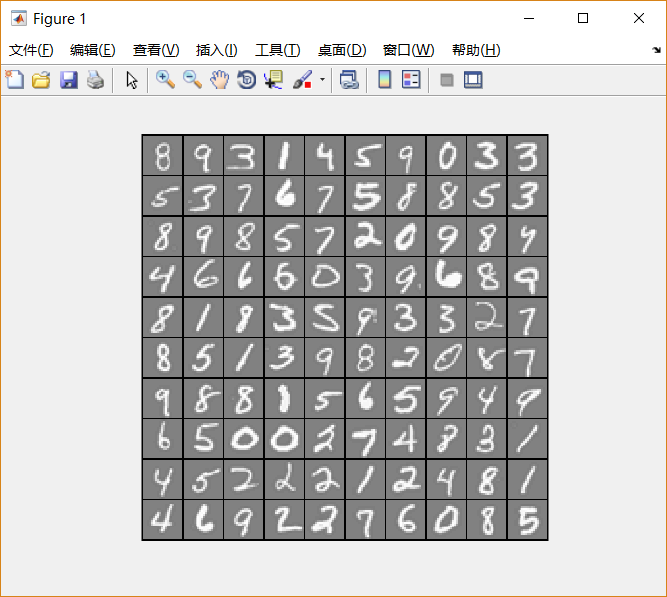
包含了5000个training example,每个training example是一张20*20像素的写有数字的灰度图。每一个像素用一个浮点数表示,代表其灰度的强度。把这个20*20的网格“展开成”一个大小为400的向量,放在矩阵 的每一行。
training example的第二部分是一个大小为5000的向量 ,作为每个 的标签。为了适配Octave/MATLAB的下标风格,这里没有0下标:"1"-"9"按"1"-"9"标记,而"0"以10标记。
1.2 Model representation
我们的神经网络如下图所示:
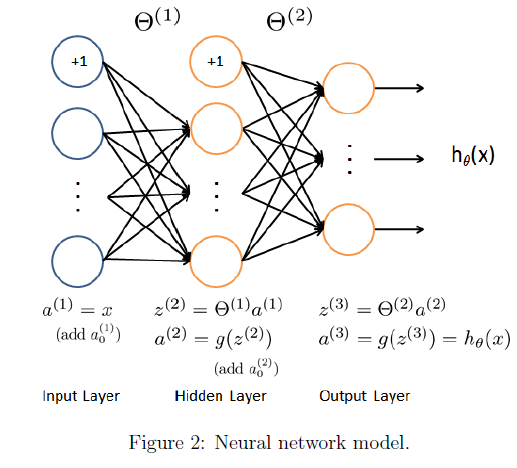
很显然,它具有三个层次:输入层,隐藏层,和输出层。注意到,我们的输入数据是一个数字的图片的像素值,而一张图片共有400个像素,这说明我们的输入层单元有400个(不算偏置单元)。
ex4weights.mat已经给我们提供了一组被训练好的参数()。他们会在ex4.m中被载入到Theta1和Theta2中,并展开成向量形式,合并存入向量nn_params中。Theta1和Theta2的大小被设置为与隐藏层中有25个单元、输出层有10个单元的情况匹配。(也就是说, 的尺寸为 , 而 的尺寸为 )。
ex4.m中这部分代码如下:
% Load the weights into variables Theta1 and Theta2load('ex4weights.mat');% Unroll parametersnn_params = [Theta1(:) ; Theta2(:)];
这里把Theta1和Theta2展开,存入了一个向量nn_params。
1.3 Feedforward and cost function
现在需要我们为神经网络计算代价函数和梯度。
神经网络的代价函数公式如下(没有经过正规化处理):
之前 的标签被定为1-10的整数,为了训练神经网络,我们需要将他们转换成如下向量形式来表示:
这样我们就可以开始计算代价函数了。
完成nnCostFunction中的代码,如下:
% Part 1% calculate the hypothetical functiona1 = [ones(m,1) X];z2 = a1 * Theta1';h1 = sigmoid(z1);a2 = [ones(size(h1,1),1) h1];h = sigmoid(a2 * Theta2');% transform y into vectorsy_vec = eye(num_labels)(y,:);% then calculate the cost functionJ = -1/m * (sum(sum(y_vec.*log(h) + (1-y_vec).*log(1-h))));
- 这里X的第 行的转置()才是第 个training example。(a1的尺寸为 )
而Theta1和Theta2的第 行则存储着z2中第 个单元所对应的权重。
因此,公式中的 , 在这里应该表示为z2 = a1*Theta1'。(尺寸为 的矩阵乘以尺寸为 的矩阵)。a2和Theta2的部分同理。 - 其中对y的处理部分有一个小技巧。先建立一个10*10的单位矩阵,那么y中值为 的数字应转换为其中的第 行。
ex4.m中这部分的代码如下:
%% ================ Part 3: Compute Cost (Feedforward) ================% To the neural network, you should first start by implementing the% feedforward part of the neural network that returns the cost only. You% should complete the code in nnCostFunction.m to return cost. After% implementing the feedforward to compute the cost, you can verify that% your implementation is correct by verifying that you get the same cost% as us for the fixed debugging parameters.%% We suggest implementing the feedforward cost *without* regularization% first so that it will be easier for you to debug. Later, in part 4, you% will get to implement the regularized cost.%fprintf('\nFeedforward Using Neural Network ...\n')% Weight regularization parameter (we set this to 0 here).lambda = 0;J = nnCostFunction(nn_params, input_layer_size, hidden_layer_size, ...num_labels, X, y, lambda);fprintf(['Cost at parameters (loaded from ex4weights): %f '...'\n(this value should be about 0.287629)\n'], J);fprintf('\nProgram paused. Press enter to continue.\n');pause;
可以看出,这里设置lambda等于0来调用nnCostFunction函数。这暂时还无关紧要,因为我们还没有进行正规化处理。
这时候运行ex4.m:

显示结果正确。
1.4 Regularized cost function
经过正规化处理后的代价函数公式如下:
以上公式是针对本次练习中的情况写的。说明中特别提到,我们可以仅考虑三层神经网络的情况,但我们的代码必须对各种大小的 和 都奏效。
这时候完成nnCostFunction中的这部分代码:
% remember that you don't have to regularize the first columnJ = J + lambda/(2*m)*(sum(sum(Theta1(:,2:end).^2))+sum(sum(Theta2(:,2:end).^2)));
在ex4.m中,这部分代码如下:
%% =============== Part 4: Implement Regularization ===============% Once your cost function implementation is correct, you should now% continue to implement the regularization with the cost.%fprintf('\nChecking Cost Function (w/ Regularization) ... \n')% Weight regularization parameter (we set this to 1 here).lambda = 1;J = nnCostFunction(nn_params, input_layer_size, hidden_layer_size, ...num_labels, X, y, lambda);fprintf(['Cost at parameters (loaded from ex4weights): %f '...'\n(this value should be about 0.383770)\n'], J);fprintf('Program paused. Press enter to continue.\n');pause;
这里lambda被设置为1。
这里要非常注意, 是不需要进行正规化的。
如果你不慎忘记了这一点(就像我一样),就会得到下面的错误结果:

修正之后,得到正确答案:

2. Backpropagation
经过之前的步骤,函数nnCostFunction已经可以返回正确的代价函数 ,接下来的步骤我们需要让它能够计算出正确的梯度。
2.1 Sigmoid Gradient
根据公式
其中
接下来利用上述公式,完成函数sigmoidGradient。函数需要对 是数字、向量、矩阵的情况都奏效。
代码如下:
function g = sigmoidGradient(z)%SIGMOIDGRADIENT returns the gradient of the sigmoid function%evaluated at z% g = SIGMOIDGRADIENT(z) computes the gradient of the sigmoid function% evaluated at z. This should work regardless if z is a matrix or a% vector. In particular, if z is a vector or matrix, you should return% the gradient for each element.g = zeros(size(z));% ====================== YOUR CODE HERE ======================% Instructions: Compute the gradient of the sigmoid function evaluated at% each value of z (z can be a matrix, vector or scalar).g = sigmoid(z) .* (1 - sigmoid(z))% =============================================================end
ex4.m中对这部分的检验代码如下:
%% ================ Part 5: Sigmoid Gradient ================% Before you start implementing the neural network, you will first% implement the gradient for the sigmoid function. You should complete the% code in the sigmoidGradient.m file.%fprintf('\nEvaluating sigmoid gradient...\n')g = sigmoidGradient([-1 -0.5 0 0.5 1]);fprintf('Sigmoid gradient evaluated at [-1 -0.5 0 0.5 1]:\n ');fprintf('%f ', g);fprintf('\n\n');fprintf('Program paused. Press enter to continue.\n');pause;
可以看出,它检验的是矩阵 。
得到结果如下:

2.2 Random initialization
在使用fminunc等高级优化算法时,我们需要提供一个 的初始值。如果我们像往常一样以零矩阵为初始,会导致每一层神经网络的不同单元相同。利用反向传播算法后,计算得到的偏导数也相同。也就是说,整个过程中,他们始终会保持相同。这是不符合要求的。
因此我们需要进行随机初始化。
采取的做法是使 处在 的范围上。
约定 。(一般的方法是根据 来得到 。)
完成randInitializeWeights中的代码如下:
function W = randInitializeWeights(L_in, L_out)%RANDINITIALIZEWEIGHTS Randomly initialize the weights of a layer with L_in%incoming connections and L_out outgoing connections% W = RANDINITIALIZEWEIGHTS(L_in, L_out) randomly initializes the weights% of a layer with L_in incoming connections and L_out outgoing% connections.%% Note that W should be set to a matrix of size(L_out, 1 + L_in) as% the first column of W handles the "bias" terms%% You need to return the following variables correctlyW = zeros(L_out, 1 + L_in);% ====================== YOUR CODE HERE ======================% Instructions: Initialize W randomly so that we break the symmetry while% training the neural network.%% Note: The first column of W corresponds to the parameters for the bias unit%% Randomly initialize the weights to small valuesepsilon_init = 0.12;W = rand(L_out, 1 + L_in) * 2 * epsilon_init - epsilon_init;% =========================================================================end
在ex4.m中这部分代码如下:
%% ================ Part 6: Initializing Pameters ================% In this part of the exercise, you will be starting to implment a two% layer neural network that classifies digits. You will start by% implementing a function to initialize the weights of the neural network% (randInitializeWeights.m)fprintf('\nInitializing Neural Network Parameters ...\n')initial_Theta1 = randInitializeWeights(input_layer_size, hidden_layer_size);initial_Theta2 = randInitializeWeights(hidden_layer_size, num_labels);% Unroll parametersinitial_nn_params = [initial_Theta1(:) ; initial_Theta2(:)];
初始化完成后,再将Theta1和Theta2展开存入一个向量中。
2.3 Backpropagation
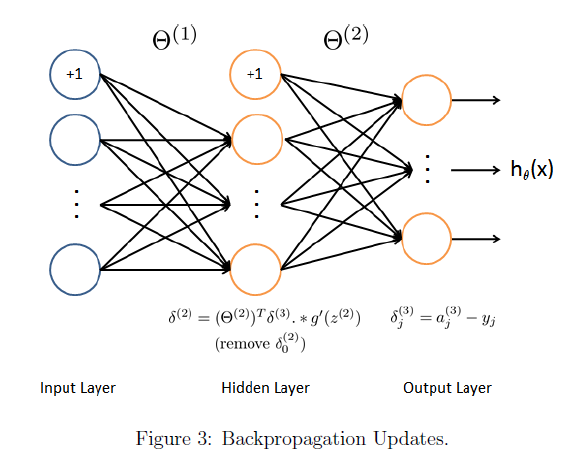
按照上面两张图所示的步骤,我们实现反向传播算法的步骤大致如下:
使用一个对i = 1:m的for循环,i表示的是training example的编号,即 。
在每次循环中,
1. 设置输入层 。使用前向传播,计算出 。 和 应该添加偏置单元。
2. 对输出层的每个单元(编号为 ), 令 ,其中 ,代表当前training example是否是第 类。
3. 对于第二层(隐藏层), 令 。而输入层不存在误差。
4. 累加以计算梯度(注意要去掉 ):
5. 计算(未经正规化的)神经网络的梯度如下:
这部分代码如下:
% Part 2d3 = h - y_vec;d2 = (d3*Theta2)(:,2:end).* sigmoidGradient(z2);D1 = d2' * a1;D2 = d3' * a2;Theta1_grad = Theta1_grad + (1/m) * D1;Theta2_grad = Theta2_grad + (1/m) * D2;
ex4.m中对这部分的检验代码:
%% =============== Part 7: Implement Backpropagation ===============% Once your cost matches up with ours, you should proceed to implement the% backpropagation algorithm for the neural network. You should add to the% code you've written in nnCostFunction.m to return the partial% derivatives of the parameters.%fprintf('\nChecking Backpropagation... \n');% Check gradients by running checkNNGradientscheckNNGradients;fprintf('\nProgram paused. Press enter to continue.\n');pause;
其中checkNNGradient是为我们提供的检验梯度的函数。
运行后结果如下:
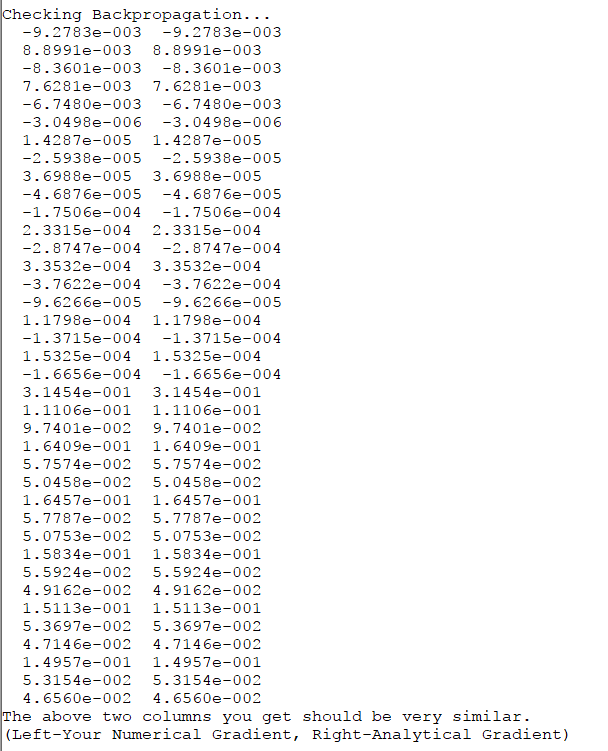
和正确答案相符。并且与gradient checking求出的差异很小:

2.4 Gradient checking
Gradient checking是用于对反向传播算法计算结果的检验。用如下方法计算:
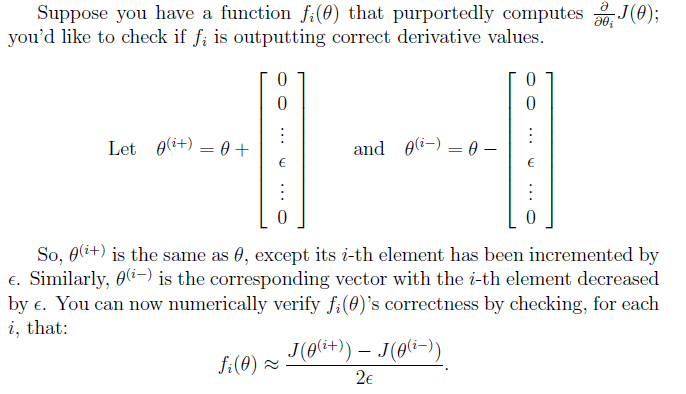
实现代码如下:
function numgrad = computeNumericalGradient(J, theta)%COMPUTENUMERICALGRADIENT Computes the gradient using "finite differences"%and gives us a numerical estimate of the gradient.% numgrad = COMPUTENUMERICALGRADIENT(J, theta) computes the numerical% gradient of the function J around theta. Calling y = J(theta) should% return the function value at theta.% Notes: The following code implements numerical gradient checking, and% returns the numerical gradient.It sets numgrad(i) to (a numerical% approximation of) the partial derivative of J with respect to the% i-th input argument, evaluated at theta. (i.e., numgrad(i) should% be the (approximately) the partial derivative of J with respect% to theta(i).)%numgrad = zeros(size(theta));perturb = zeros(size(theta));e = 1e-4;for p = 1:numel(theta)% Set perturbation vectorperturb(p) = e;loss1 = J(theta - perturb);loss2 = J(theta + perturb);% Compute Numerical Gradientnumgrad(p) = (loss2 - loss1) / (2*e);perturb(p) = 0;endend
2.5 Regularized neural networks
正规化后的偏导数公式如下:
只需增加如下代码:
% Part 3Theta1_grad(:,2:end) = Theta1_grad(:,2:end) + (lambda/m)*(Theta1(:,2:end));Theta2_grad(:,2:end) = Theta2_grad(:,2:end) + (lambda/m)*(Theta2(:,2:end));
ex4.m中这部分检验代码:
%% =============== Part 8: Implement Regularization ===============% Once your backpropagation implementation is correct, you should now% continue to implement the regularization with the cost and gradient.%fprintf('\nChecking Backpropagation (w/ Regularization) ... \n')% Check gradients by running checkNNGradientslambda = 3;checkNNGradients(lambda);% Also output the costFunction debugging valuesdebug_J = nnCostFunction(nn_params, input_layer_size, ...hidden_layer_size, num_labels, X, y, lambda);fprintf(['\n\nCost at (fixed) debugging parameters (w/ lambda = %f): %f ' ...'\n(for lambda = 3, this value should be about 0.576051)\n\n'], lambda, debug_J);fprintf('Program paused. Press enter to continue.\n');pause;
注意到这里checkNNGradient函数这里带上了参数lambda。这里它被设置为3.
因为在该函数里可以看到如下部分:
if ~exist('lambda', 'var') || isempty(lambda)lambda = 0;end
可以看到不输入参数时,lambda被设置为0。
再次检验可以看出,结果依然正确。
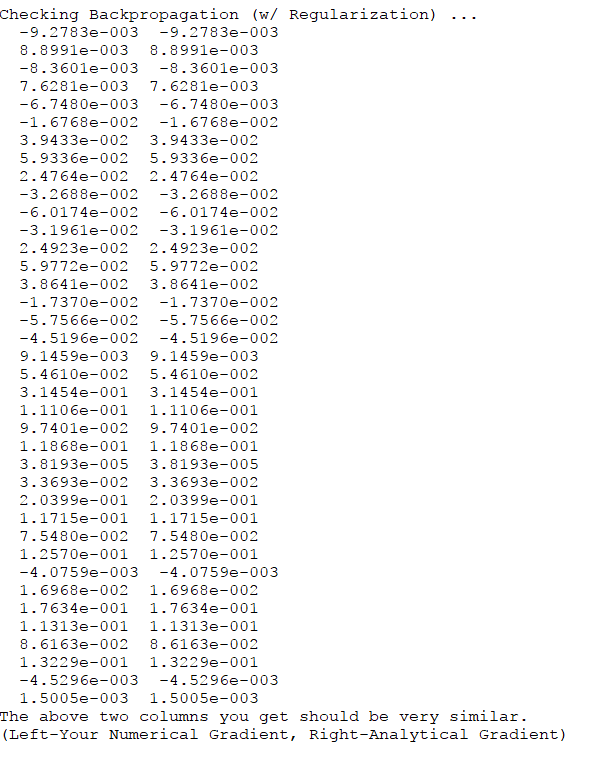


2.6 Learning parameters using fmincg
计算完成后,将training example代入检验准确率。一般来说,准确率大概在95.3%左右。
ex4.m中这部分代码如下:
%% =================== Part 8: Training NN ===================% You have now implemented all the code necessary to train a neural% network. To train your neural network, we will now use "fmincg", which% is a function which works similarly to "fminunc". Recall that these% advanced optimizers are able to train our cost functions efficiently as% long as we provide them with the gradient computations.%fprintf('\nTraining Neural Network... \n')% After you have completed the assignment, change the MaxIter to a larger% value to see how more training helps.options = optimset('MaxIter', 50);% You should also try different values of lambdalambda = 1;% Create "short hand" for the cost function to be minimizedcostFunction = @(p) nnCostFunction(p, ...input_layer_size, ...hidden_layer_size, ...num_labels, X, y, lambda);% Now, costFunction is a function that takes in only one argument (the% neural network parameters)[nn_params, cost] = fmincg(costFunction, initial_nn_params, options);% Obtain Theta1 and Theta2 back from nn_paramsTheta1 = reshape(nn_params(1:hidden_layer_size * (input_layer_size + 1)), ...hidden_layer_size, (input_layer_size + 1));Theta2 = reshape(nn_params((1 + (hidden_layer_size * (input_layer_size + 1))):end), ...num_labels, (hidden_layer_size + 1));fprintf('Program paused. Press enter to continue.\n');pause;
按照迭代次数50次,lambda设置为1来计算,得到如下结果:
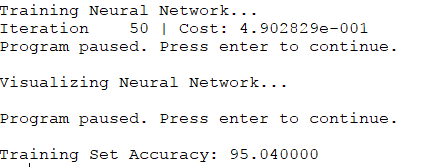
基本吻合。
3 Visualizing the hidden layer
输出隐藏层图形。
3.1 Optional exercise
如果未经正规化,可能会出现overfit的情况:对于training examples可能非常吻合,却不一定适用于新出现的情况。
我们把lambda设置得很小,迭代次数设置得很大,就容易出现这样的情况。
迭代次数:50, lambda=1,如下图:
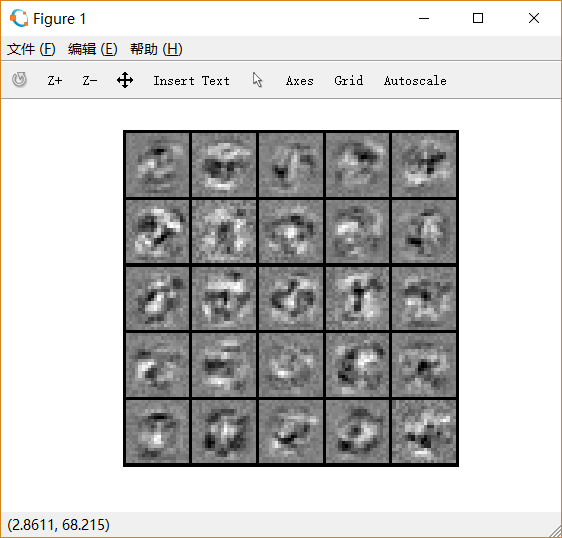
迭代次数:400, lambda=1, 如下图:
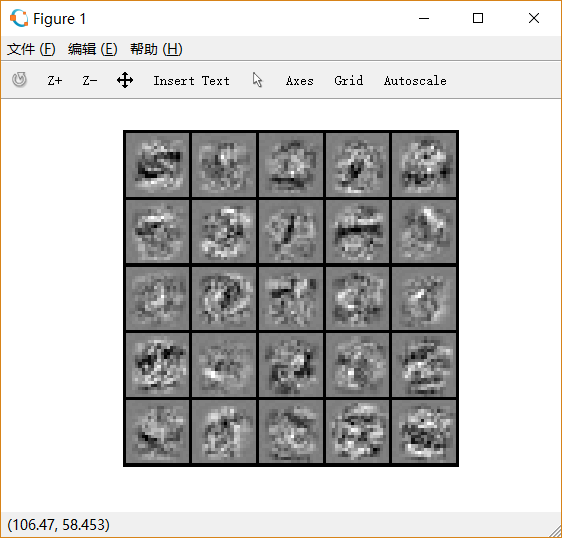
迭代次数:700, lambda=0.1, 如下图:
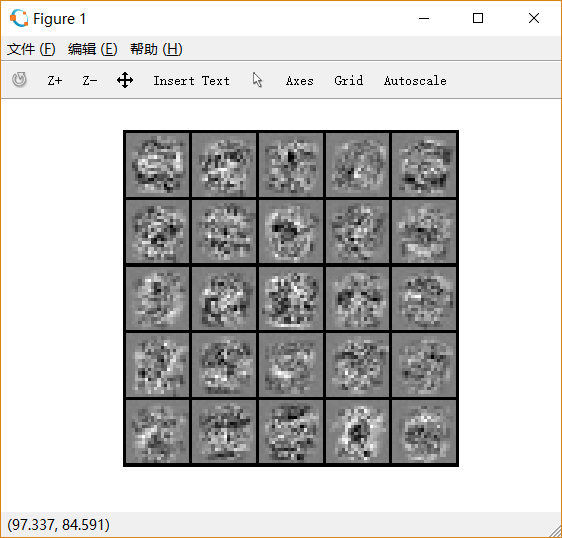
后两次的training accuracy都接近100%。
